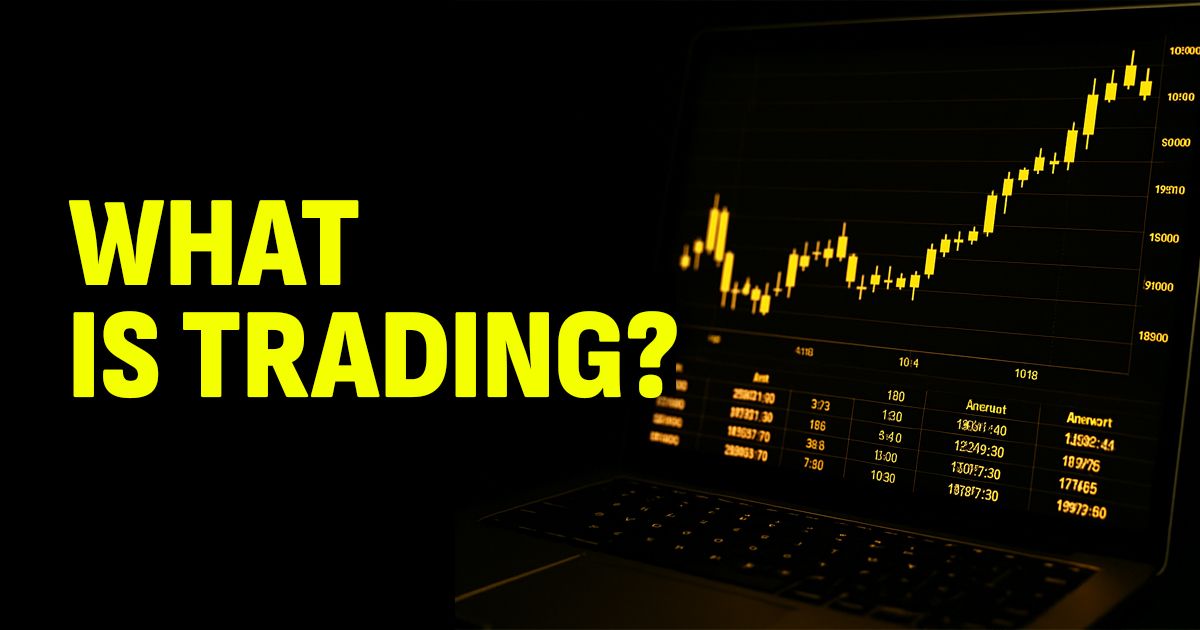Trading is one of the oldest and main activities in human civilization. At its core, trading is the act of buying and selling goods, services, or financial instruments between individuals, businesses, or countries. It plays an important role in both the global economy and our daily lives. Every time we purchase groceries, invest in stocks, or buy something online, we are participating in a form of trade.
Table of contents
- Main Concepts of Trading
- Trading History
- Types of Trading
- How Trading Works
- Trading: Risks and Advantages
- Who Is Trading For?
- Conclusion
Earlier, bartering systems existed, and now, trading has evolved into a complex system that connects economies, shapes industries, and influences political and social structures. If you want to know how wealth is generated, distributed, and multiplied, you shall know about trading.
Main Concepts of Trading
What Is Trading? Trading Types and Forms
Trading can take many forms that depend on the nature of the transaction and the scale of the exchange. The following are the main trading forms:
Wholesale trading means buying goods in large quantities. Normally, goods are bought from manufacturers, and they are later resold in smaller lots to retailers or other businesses.
Retail trading is the sale of goods directly to the consumer. It occurs normally through stores or online platforms.
International trading involves the exchange of goods and services across borders, it is often regulated by trade agreements and tariffs.
Who Are the Participants in Trading
The trade process usually involves three main categories of participants:
- Sellers, or those who offer goods or services.
- Buyers, those are individuals or organizations who buy products or services.
- Intermediaries, they include brokers, agents, and wholesalers. They connect buyers with sellers or provide logistical and financial services.
Main Principles of Trade
There are some main principles that impact trading. The first one is demand and supply. It means that prices are determined by the availability of a product and how much people want it. Another principle is price discovery. This is the market process that sets the prices for goods and services. The final, third principle is market equilibrium. It takes place when supply matches demand. It leads to a stable price.
Trading History
From Barter to Modern Markets
The earliest form of trade was barter. Goods and services were exchanged, no money was used. A farmer could trade grain for tools, or textiles for livestock. This system was limited because there was a lack of a standard value system and it was difficult to match needs between parties.
When money was invented, everything changed. Traders could then assign value to goods and exchange them more efficiently. Civilizations grew, and the trading complexity also increased.
Evolution and Globalization of Trade
Maritime travel and tech advancements speeded up the trade development. The Silk Road, the spice trade, and later colonial trade routes all helped connect distant parts of the world. They created cultures and economies
In modern times, globalization has made international trade faster and more interconnected. Products made in one country are often assembled in another and sold all around the world.
The Role of Technology in Trading
Technology has boosted the development of trading. The rise of the internet enabled e-commerce. It allowed people to buy and sell products from anywhere in the world. In financial markets, algorithmic and high-frequency trading now dominate, and computers execute thousands of trades per second.
Types of Trading
Goods and Services Trading
This is the most traditional form of trade. It is trading physical products like food, clothing, electronics, or services such as education, healthcare, and transport.
Financial Trading
Financial trading refers to the buying and selling of financial instruments such as stocks, bonds, currencies, and cryptocurrencies.
E-Commerce and Digital Trade
E-commerce is the online trading of goods and services. It happens by using websites or apps. Platforms like Amazon, eBay, and Alibaba have changed how retail trade works. E-commerce also includes digital products, such as software, courses, or digital art. They can be delivered asap to buyers all around the world.
How Trading Works
The trade process starts with identifying the need. Then, you look for a seller or a buyer, negotiate the price, and finalize the transaction.
In financial trading, this happens on platforms or exchanges with advanced tools, charts, and algorithms.
Markets, Exchanges, and Platforms
- Commodity markets (like oil, gold, and wheat) are often centralized through commodity exchanges.
- Stock markets like the New York Stock Exchange or Nasdaq facilitate equity trading.
- Online marketplaces (e.g., Amazon, Etsy) allow peer-to-peer retail trading. Each type of platform has unique features, but all serve to connect buyers and sellers.
Trading: Risks and Advantages
Trading comes with its benefits and challenges.
Advantages
- Economic growth: Trade generates jobs, stimulates production, and increases GDP.
- Consumer choice: Trade allows access to a wider variety of goods and services.
- Innovation: Competition in trade contributes to innovation.
- Global integration: International trade creates diplomatic and cultural connections.
Risks
- Market competition: Very high competition can harm small businesses.
- Price fluctuations: Volatility in markets like Forex or crypto can lead to losses.
- Legal issues: Cross-border trade involves complex regulations, tariffs, and compliance.
- Fraud and scams: Especially in online and digital trading.
Risk Mitigation
To reduce risks, educate yourself. Research each asset in which you want to invest, and diversify assets. Always use only reputable platforms to trade.
Who Is Trading For?
Businesses and individuals use trading. For example, businesses sell products, materials, and grow. Wholesale and retail trading are very important for economic growth. People buy and sell assets to earn. They can trade in short-term or invest in the long term.
Conclusion
Trading is important for economies and people. It touches all parts of our lives. If you buy food or invest in global markets, you trade. This is why it is important to know how trading works and how to make informed decisions.

